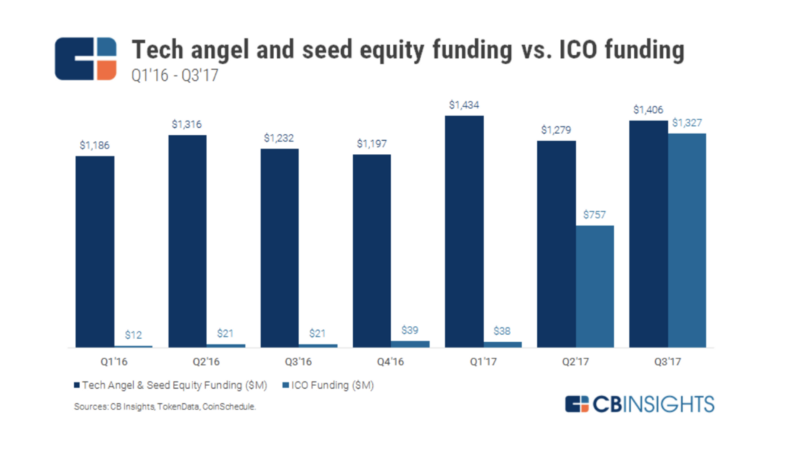The great blockchain roller-coaster
By David Devils
Five years ago ICOs were an unknown method of fundraising. Back then, two projects raised $800,000. Now ICOs have become a workable alternative to VCs, hedge funds and angel investments, and many blockchain startups choose it. The number of funds attracted via ICO has grown rapidly, so has regulator attention and investor scepticism, leading us to the evolving and maturing ICO market today. I’d like to discuss whether ICO’s are the only viable way to fund blockchain startups.
The ICO market’s grown to over $7 billion being raised in 2017. This rapid growth is set to continue with ICO unicorns, such as EOS (over $4 billion raised) and Telegram ($1,7 billion raised), paving their way in 2018. According to Coinschedule, this year, ICOs have already outperformed last year’s results with a total of $20 billion YTD. The ICO market has positive facets, although the environment itself has changed.
Short Story in Numbers
At early stages, ICOs quickly became the fastest form of crowdfunding, with almost no regulatory oversight, no strict requirements and literally anyone being able to participate. An ICO was a new, attractive, decentralized, unregulated and overtly risky way to raise millions within hours. Unqualified investors, were very eager to part with their money in hopes of extreme returns. Multiple projects used ICOs as a tool to avoid the highly regulated apparatus of traditional financial markets. Being able to raise funds for groundbreaking innovations with such ease of access to millions of dollars, with little to no retribution, naturally attracted many scam artists. Hundreds of ICOs, to put it simply, took advantage of the market’s immaturity and anonymity.
According to research conducted by Statis Group, almost 80% (by share) of last year’s ICOs were a scam, 4% failed, and 3% faded away. The most famous scam was the DAO in 2016 where $150 million was raised in minutes and later stolen.
Of course, not all projects were a failure or had ill intentions. Some of the largest ICOs in 2017: Filecoin ( $257 million), Bancor ( $153 million), Paragon ($120 million) are continuously working on delivering on their promise.
Current Condition of the ICO Market
Along with successes, failures, and scams, I may say, the ICO market environment in 2017 was growing and maturing, merging paths of founders, project teams, investors, and regulators.
Today we generally see some common traits emerging in the ICO market.
- Regulators are joining the game, defining security tokens.
- Institutional investors are entering the ICO market.
- Projects have become more mature and responsible in preparing for the ICO run.
- Entry barriers have risen, decreasing the number of scammers.
- Viable projects are failing to raise capital due to a lack of experience and expertise.
A Perspective of the ICO Market
What is the ICO market up to? As blockchain tech evolves, I think, fundraising via token issuance is going to stick around. I’d suggest the approaches to ICOs are changing. ICOs are no longer recognized as the only way to fund blockchain startups. As the market barriers are high and investors are pickier, companies won’t add an artificial blockchain layer to every project just to get access to capital and will be more prepared for fundraising in the traditional sense. I believe, in such new conditions, only innovative projects solving real market problems, backed by years of experience in their respective fields, will survive.
I’d predict, ICOs will repeat the story of startups and later crowdfunding. When in 2011 Kickstarter kicked off, it was believed it would kill the early stage investment round. It didn’t. Crowdfunding became just one more tool to raise funds. In 2017 the ICO was supposed to hit the VC industry. And again, it didn’t happen. So, ICO is becoming just one tool, among other alternatives, to raise funds, in line with VCs, family offices, angel investors, private equity firms and accelerators.
According to a report published by CB Insights, VC and angel investors are ready to invest in blockchain projects and were always ready. What’s more is, in the third quarter of 2017 (just before the beginning of the decline) tech, angel and seed equity made up north of $1.4 billion, while ICOs made up roughly $1.3 billion. See the graph below for details.

Use Everything You Need to Succeed
I’d say the hybrid approaches to fundraising are taking a lead this year. This is what we’re up to at ToTheMoon Lab: combining various approaches to make projects live.
Depending on the idea, market readiness, and level of risk involved, for each stage of the project, different strategies may be applied. In 2018 I suggest considering different ways to fundraise, depending on the project type, definitely not including tokens simply for investment reasons only. If you’re dealing with a top-notch project, that’s ten times more effective than its competitors, offers a new business model or solves significant industry problems, consider dealing with VCs, at least in the first stages. If it’s a blockchain project, with good governance and needs a large crypto community, take a closer look at ICOs: private sales for covering your soft cap and reserving the public sale to attract your first clients.
There’s no magic solution or one right way to raise funds. Every project’s unique. For every project, you need to build a tailored strategy to enter the market and raise capital. And this is what we’re doing at ToTheMoon Lab. Being in the market for some time, I’ve created the following must have guidelines:
- Come up with a great idea for solving a serious problem, people will pay to have solved
- Create a dedicated team with the relative experience in the field.
- Create the first prototype/ MVP and make marketing tests via FFF.
- Assess product/market fit.
- Develop a detailed business plan and get ready to attract partners and build a community.
- Attract investors from the top crypto and VC funds.
- Prepare for the ICO, if needed.
Last but not least, be flexible and don’t forget to adapt. Always bear in mind that any method of raising funds is just a tool to bring your project to life.
So tell me, are you up for a ride, or will you stand by and watch others take the plunge into the world of blockchain, and then wish you also did years from now?

